|
Réponse |
Message 1 de 39 de ce thème |
|
|
|
|
|
Réponse |
Message 2 de 39 de ce thème |
|
|
|
|
Réponse |
Message 3 de 39 de ce thème |
|
1. Job 9:9: El hizo la Osa (Arturo) , el Orión y las Pléyades,Y los lugares secretos del sur;
Arturo (estrella)
De Wikipedia, la enciclopedia libre
«Arcturus» redirige aquí. Para la banda noruega de black metal/avant-garde, véase Arcturus (banda).
| Arturo |
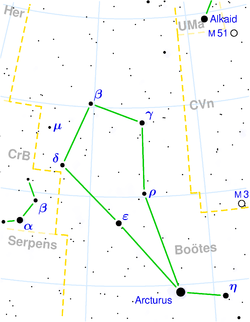
Ubicación de Arturo en la constelación de Boötes. |
Datos de observación
(Época J2000.0) |
| Constelación |
Boötes |
| Ascensión recta (α) |
14h 15m 39,67s |
| Declinación (δ) |
+19° 10′ 56,7″ |
| Mag. aparente (V) |
−0,04 |
| Características físicas |
| Clasificación estelar |
K1.5III |
| Masa solar |
1 – 1,5 M☉ |
| Radio |
(25,7 ± 0,3[1] R☉) |
| Índice de color |
1,24 (B-V)
1,22 (U-B) |
| Magnitud absoluta |
−0,29 |
| Luminosidad |
215[2] L☉ |
| Temperatura superficial |
4.290 K |
| Metalicidad |
20 – 50% del Sol |
| Variabilidad |
Posible |
| Edad |
> 4,6 × 109 |
| Astrometría |
| Mov. propio en α |
−1093,45 mas/año |
| Mov. propio en δ |
−1999,40 mas/año |
| Velocidad radial |
−5,2 km/s |
| Distancia |
36,7 ± 0,3 años luz |
| Paralaje |
88,78 ± 0,68 mas |
| Referencias |
| SIMBAD |
enlace |
| Otras designaciones |
| Aramec, Abramech, α Boötis, 16 Boötis, HD 124897, HR 5340, BD+19°2777, GCTP 3242.00, GJ 541, LHS 48, y HIP 69673 |
Arturo o Arcturus (Alfa Bootis / α Boo / 16 Bootis) es la tercera estrella más brillante del cielo nocturno con una magnitud visual de -0,04, después de Sirio (α Canis Majoris) y Canopus (α Carinae); considerando juntas las dos componentes principales de Alfa Centauri, que no se pueden resolver a simple vista, Arturo pasa a ser la cuarta estrella más brillante. Se trata, por lo tanto, de la estrella más brillante del hemisferio celeste norte. Su constelación es Boötes, «El Boyero». Se encuentra en la Nube Interestelar Local.
[editar] Etimología e historia

Forma de encontrar a Arturo en el cielo, a partir de la Osa Mayor.
El nombre de Arturo proviene del griego antiguo Αρκτοῦρος (Arcturus), «el guardián del oso» y está relacionado con su proximidad a las constelaciones de la Osa Mayor (Ursa Major) y la Osa Menor (Ursa Minor). En árabe recibe el nombre de As-Simak ar-Ramih (السماك الرامح), traducido por «la pierna del que porta la lanza» o «el noble que porta la lanza». Este nombre, romanizado en el pasado, ha dado lugar a los nombres de Aramec y Azimech, hoy obsoletos. Otro nombre árabe es Al-Harith as-Sama' (الحارس السماء), «el que guarda los cielos».[3] [4]
En el antiguo Egipto parece que era conocida como Smat, «el que reina» o «el que gobierna», así como Bau, «el que viene».[5] Un calendario astronómico egipcio del siglo XV a.C. asocia a Arturo con Antares (α Scorpii) en una inmensa figura celestial llamada Menat. Para algunos autores era uno de los astros de culto en los templos del Nilo y en el templo de Venus en Ancona (Italia).[6]
En astronomía hindú corresponde a la nakshatra —una de las mansiones en las que se divide el cielo— de Svātī; allí también se la llamaba Nishṭya, «fuera», posiblemente por su localización boreal lejos del zodíaco. En China era conocida como Ta Kiō, «el gran cuerno», mientras que cuatro pequeñas estrellas cercanas eran Kang Che, «el lago de la sequía».[6]
En aragonés se la llama Petarruego, probablemente una denominación formada por el verbo petar y por el antiguo adjetivo royo («rojo»).
[editar] Características físicas

Tamaño de Arturo en comparación con el Sol.
Arturo es una gigante naranja de tipo espectral K1.5III, distante 36,7 años luz del Sistema Solar, la segunda estrella gigante más próxima después de Pólux (β Geminorum). Con una temperatura superficial de 4290 K, es visualmente 113 veces más luminosa que el Sol; pero si se considera la radiación que emite en el infrarrojo, su luminosidad es casi el doble, 215 veces mayor que la solar. Su radio, obtenido a partir de la medida de su diámetro angular (0,0210 segundos de de arco), es 25,7 veces más grande que el radio solar. Su masa es aproximadamente un 50% mayor que la del Sol y se piensa que en su núcleo interno ya ha comenzado la fusión nuclear de helio en carbono. Emite rayos X débiles, lo que sugiere que posee actividad magnética —pudiendo tener una «corona oculta»—, algo inusual en una estrella de sus características.[2] Se sospecha que puede ser una estrella variable, habiendo recibido la denominación de NSV 6603.[7]
La velocidad relativa de Arturo respecto al Sol, mayor que la de otras estrellas brillantes, así como su baja metalicidad —aproximadamente un 28% de la solar—, sugieren que puede ser una estrella vieja de Población II y un miembro del disco grueso galáctico.[8] [9] Forma parte de un grupo de 53 estrellas que se mueven conjuntamente a través de nuestra galaxia y que recibe el nombre de «Grupo de Arturo».[10] Una interesante teoría sostiene que Arturo, así como el resto de estrellas que forman su grupo, se han formado más allá de los confines de la Vía Láctea; la edad de algunos de sus miembros puede remontarse hasta los 10.000 - 12.000 millones de años, lo que implicaría que pueden provenir de una galaxia satélite absorbida en el pasado por nuestra propia galaxia.[11]
[editar] Véase también
http://es.wikipedia.org/wiki/Arturo_(estrella)
|
|
|
|
Réponse |
Message 4 de 39 de ce thème |
|
Sirius and Orion Over Washington
The Congress of Isis and Osiris just so happens to happen above... Congress.
Washington D.C. and many of it's buildings and monuments are laid out according to the cardinal directions with the streets running due NS and EW.
In the map of Washington D.C. below, due east is up and the star chart shows the constellation of Orion rising due east over Washington D.C., as it has done every day for the past two hundred years.
Orion's belt points towards Sirius, the brightest star in the sky, and while Orion is rising and low on the eastern horizon, Orion's belt is vertical, pointing to Sirius below.
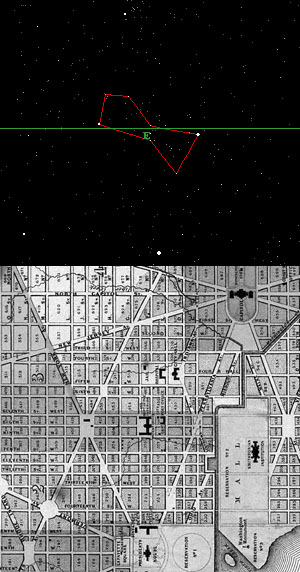
In relation to the fixed stars, the sun rises later each day due to the rotation of the earth around the sun.
The sun rises just after Sirius at the latitude of Washington D.C. on August 15. This is known as the heliacal rising of Sirius. Prior to this time of year, the sun is above or too close to the horizon for the rising of the star to be visible.
Ancient Egyptians based their calendar on the heliacal rising of Sirius, which signaled the onset of the annual flooding of the Nile. Christians celebrate the Assumption of the Virgin Mary on August 15, linking the Assumption to the first appearance of Sirius/Isis in the sky just before dawn.
Orion has also set due west at the latitude of Washington D.C. for the past two hundred years.
From the viewpoint of the Capitol building, Orion sets right behind the Washington Monument. Setting in the west, Orion's belt is horizontal, pointing to Sirius setting south of due west.
From the viewpoint of the Capitol building, Sirius sets over the Potomac River, on the alignment of Maryland Avenue. The bright star above Orion is Aldebaran, the alpha star in the constellation of Taurus.
From the viewpoint of the Capitol building, Aldebaran sets over the White House, on the alignment of Pennsylvania Avenue.
Source
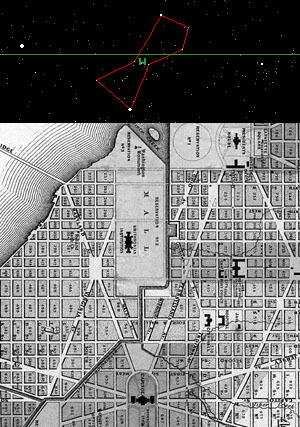
It has already been established that the Goddess can be symbolized by an owl.
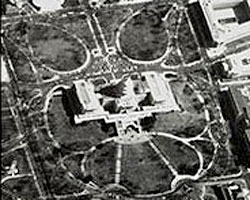
Columbia and the Constellation of Virgo
The District of Columbia has more astrological symbols than and other city in the world. The capitol city was built from the ground up with a specific esoteric design.
There were many changes however, and some things didn't go exactly to plan.
In David Ovason’s book, The Secret Architecture of our Nation’s Capital ... The District of Columbia and its Federal City were arranged, according to Ovason, so that the constellation of Virgo and its goddess symbolism dominates the structure.
Ovason notes that the right triangle of first magnitude stars that contains the constellation Virgo, Arcturus, Regulus and Spica, can also be found in the plan of the Federal city marked by the location of the Capital, the President’s House and the Washington Monument.
And he also notes that the consecration ceremonies for these sites all include prominent astrological connections to Virgo...
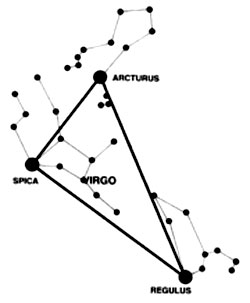
This earth/sky alignment can be seen every year, weather permitting, around August 10th, as the sun sets down the Pennsylvania avenue sight line from the Capital, the great triangle enclosing Virgo appears in the darkening sky.
It was not as obvious 200 years ago when the plan was laid out, but now, at the moment of culmination, the alignment is clear and unmistakable.
As Ovason insists, it is plain that from its inception, the District of Columbia, and the Federal City,
“was intended to celebrate the mysteries of Virgo - of the Egyptian Isis, the Grecian Ceres and the Christian Virgin."
Source
http://www.bibliotecapleyades.net/sociopolitica/esp_sociopol_washingtonDC09.htm
|
|
|
|
Réponse |
Message 5 de 39 de ce thème |
|
| |
New International Version (©1984)
He is the Maker of the Bear and Orion, the Pleiades and the constellations of the south.
New Living Translation (©2007)
He made all the stars--the Bear and Orion, the Pleiades and the constellations of the southern sky.
English Standard Version (©2001)
who made the Bear and Orion, the Pleiades and the chambers of the south;
New American Standard Bible (©1995)
Who makes the Bear, Orion and the Pleiades, And the chambers of the south;
King James Bible (Cambridge Ed.)
Which maketh Arcturus, Orion, and Pleiades, and the chambers of the south.
GOD'S WORD® Translation (©1995)
He made [the constellations] Ursa Major, Orion, and the Pleiades, and the clusters of stars in the south.
King James 2000 Bible (©2003)
Who makes the Bear, Orion, and Pleiades, and the chambers of the south.
American King James Version
Which makes Arcturus, Orion, and Pleiades, and the chambers of the south.
American Standard Version
That maketh the Bear, Orion, and the Pleiades, And the chambers of the south;
Douay-Rheims Bible
Who maketh Arcturus, and Orion, and Hyades, and the inner parts of the south.
Darby Bible Translation
Who maketh the Bear, Orion, and the Pleiades, and the chambers of the south;
English Revised Version
Which maketh the Bear, Orion, and the Pleiades, and the chambers of the south.
Webster's Bible Translation
Who maketh Arcturus, Orion, and Pleiades, and the chambers of the south.
World English Bible
He makes the Bear, Orion, and the Pleiades, and the rooms of the south.
Young's Literal Translation
Making Osh, Kesil, and Kimah, And the inner chambers of the south.
|
|
|
|
|
|
Réponse |
Message 6 de 39 de ce thème |
|
Sacred land or high land, the name of a country on one of the mountains of which the ark rested after the Flood subsided ( Genesis 8:4). The "mountains" mentioned were probably the Kurdish range of South Armenia. In 2 Kings 19:37, Isaiah 37:38, the word is rendered "Armenia" in the Authorized Version, but in the Revised Version, "Land of Ararat." In Jeremiah 51:27, the name denotes the central or southern portion of Armenia. It is, however, generally applied to a high and almost inaccessible mountain which rises majestically from the plain of the Araxes. It has two conical peaks, about 7 miles apart, the one 14,300 feet and the other 10,300 feet above the level of the plain. Three thousand feet of the summit of the higher of these peaks is covered with perpetual snow. It is called Kuh-i-nuh, i.e., "Noah's mountain", by the Persians. This part of Armenia was inhabited by a people who spoke a language unlike any other now known, though it may have been related to the modern Georgian. About B.C. 900 they borrowed the cuneiform characters of Nineveh, and from this time we have inscriptions of a line of kings who at times contended with Assyria. At the close of the seventh century B.C. the kingdom of Ararat came to an end, and the country was occupied by a people who are ancestors of the Armenians of the present day. |
|
|
|
Réponse |
Message 7 de 39 de ce thème |
|
| Fixed star: ARCTURUS |
| Constellation: Alpha (α) Bootes |
| Longitude 1900: 22LIB50 |
Longitude 2000: 24LIB14 |
| Declination 1900: +19.42' |
Declination 2000: +19.11' |
| Right ascension: 14h 15m |
Latitude: +30.44' |
| Spectral class: K2 |
Magnitude: -0.04 |
The history of the star: Arcturus
from p.98 of Star Names, Richard Hinckley Allen, 1889.
[A scanned copy can be viewed on this webpage]
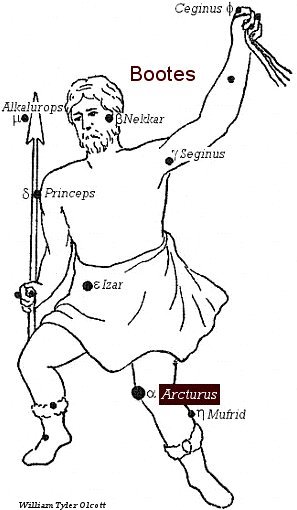 Alpha (α) Bootes, Arcturus, is a golden red star situated on the left knee of the Herdsman, the 4th brightest in the sky. Alpha (α) Bootes, Arcturus, is a golden red star situated on the left knee of the Herdsman, the 4th brightest in the sky.
Arcturus has been an object of the highest interest and admiration to all observant mankind from the earliest times, and doubtless was one of the first stars to be named; for from Hesiod's day to the present it thus appears throughout all literature, although often confounded with the Greater Bear (Ursa Major). Indeed Hesiod's use of the word probably was for that constellation (Bootes), except in two cases, already quoted, where he unquestionably referred to this star, mentioning its rising fifty days after the winter solstice, the first allusion that we have to that celestial point. And it is popularly supposed that {p.99} our Arcturus is that of the Book of Job, xxxviii, 32; but there it merely is one of the early titles of Ursa Major, the Revised Version correctly rendering it "the Bear." Still, even now, the Standard Dictionary quotes for the star the Authorized Version's
"Canst thou guide Arcturus with his sons ?"
But, like other prominent stars, it shared its name with its constellation — in fact, probably at first, and as late as Pliny's day (23-79 A.D.), was a constellation by itself. Homer's Bootes doubtless was this, with, possibly, a few of its larger companions; and the 17th century German astronomer Bayer cited Bootes for the star; but in recent times the latter has monopolized the present title.
It was famous with the seamen of early days, even from the traditional period of the Arcadian Evander, and regulated their annual festival by its movements in relation to the sun. But its influence always was dreaded, as is seen in the Greek astronomer Aratus', circa 270 B.C., deinou Arktouroio and Pliny's (23-79 A.D.) horridum sidus; while Demosthenes, in his action against Lacritus 341 B.C., tells us of a bottomry bond, made in Athens on a vessel going to the river Borysthenes — the modern Dnieper—and to the Tauric Chersonese—the Crimea—and back, that stipulated for a rate of 22 ½ per cent, interest if she arrived within the Bosporus "before Arcturus," i.e. before its heliacal rising about mid-September; after which it was to be 30 per cent. Its acronycal rising fixed the date of the husbandmen's Lustratio frugum; and Vergil (70-19 B.C.) twice made allusion in his 1st Georgic to its character as unfavorably affecting the farmers' work. Other contemporaneous authors confirmed this stormy reputation, while all classical calendars gave the dates of its risings and settings.
Hippocrates, 460 B.C., made much of the influence of Arcturus on the human body, in one instance claiming that a dry season, after its rising,
"agrees best with those who are naturally phlegmatic, with those who are of a humid temperament, and with women; but it is most inimical to the bilious;"
and that
"diseases are especially apt to prove critical in these days."
{p.100} The Prologue of the Rudens of Plautus, delivered by Arcturus in person, and "one of the early opinions of the presence of invisible agents amongst mankind," declares of himself that he is considered a stormy sign at the times of his rising and setting,— as the original has it:
"Arcturus signum, sum omnium quam acerrimum. Vehemens sum, cum exorior, cum occido vehementior."
And the passage from Horace's (65-8 B.C.) Odes —
"Nec saevus Arcturi cadentis Impetus aut orientis Haedi —"
is familiar to all. This same idea came down to modern days, for Pope repeated it in his verse,
"When moist Arcturus clouds the sky."
Astrologically, however, the star brought riches and honor to those born under it.
An Egyptian astronomical calendar of the 15th century before Christ, deciphered by Renouf, associates it with the star Antares in the immense sky figure Menat; and Lockyer claims it as one of the objects of worship in Nile temples, as it was in the temple of Venus at Ancona in Italy.
In India it was the 13th nakshatra (Hindu Moon Mansion), Svati, the Good Goer, or perhaps Sword, but figured as a Coral Bead, Gem, or Pearl; and known there also as Nishtya, Outcast, possibly from its remote northern situation far outside of the zodiac, whence, from its brilliancy, it was arbitrarily taken to complete the series of Hindu asterisms. Hewitt thinks that it, or Capella, was the Aryaman of the Rig Veda; and Edkins that it was the Tistar usually assigned to Sirius.
The Chinese called it Ta Kio, the Great Horn, four small stars near by being Kang Che, the Drought Lake; Edkins further writing of it:
"Arcturus is the palace of the emperor. The two groups of three small stars on its right [eta, iota (ι), and upsilon (υ)] are called She ti, the Leaders, because they assign a fixed direction to the tail of the Bear, which, as it revolves, points out the twelve hours of the horizon."
The Arabs knew Arcturus as Al Simak1 al Ramih (Allen notes: This word Simak is from a root meaning "to raise on high," and is thought to have been employed by the Arabs when they wished to indicate any prominent object high up in the heavens, but with special reference to this star and to the other Simak, Spica of the Virgin.), sometimes translated the Leg of the Lance-bearer, and again, perhaps more correctly, the Lofty {p.101} Lance-bearer. From the Arabic title came various degenerate forms: Al Ramec, Aramec, Aremeah, Ascimec, Azimech, and Azimeth, found in thou queer compendiums of stellar nomenclature the Alfonsine Tables and the Almagest of 1515; Somech haramach of English writer on globes John Chilmead (circa 1639)'s Treatise; and Aramakh, which Karsten Niebuhr heard from the Arabs 136 years ago. The Kheturus of their predecessors, already alluded to under Bootes, also was used for this.
The idea of a weapon again manifested itself in the Kontaratos, Javelin-bearer, of the Graeco-Persian Tables; while the 17th century German astronomer Bayer had Gladius, Kolanza, and Pugio, all applied to Arcturus, which probably marked in some early drawing the Sword, Lance, or Dagger in the Hunter's hand. Similarly it took the title Alkameluz of the whole constellation.
Al Haris al Sama, the Keeper of Heaven, perhaps came from the star's early visibility in the twilight owing to its great northern declination, as though on the lookout for the safety and proper deportment of his lesser stellar companions, and so "Patriarch Mentor of the Train." This subsequently became Al Haris al Simak, the Keeper of Simak, probably referring to Spica, the Unarmed One.
The Persian astronomer Al Biruni (973-1048 A.D.) mentioned Arcturus as the Second Calf of the Lion, the early Asad [Arabs had an enormous Lion, their early Asad, extending over a third of the heavens, of which the stars Arcturus and Spica were the shin-bones; Regulus, the forehead; the heads of Gemini, one of the fore paws; Canis Minor, the other; and Corvus, the hind quarters. Many Arab starnames come from this tradition. Star Names p.97.]; Spica being the First Calf.
It has been identified with the Chaldaeans' Papsukal, the Guardian Messenger, the divinity of their 10th month Tibitu; while Smith and Sayce have said that on the Euphrates it was the Shepherd of the Heavenly Flock, or the Shepherd of the Life of Heaven, undoubtedly the Sib-zi-anna of the inscriptions; the star eta (η) (Mufrid) being often included in this, and thus making one of the several pairs of Euphratean Twin Stars.
The 1515 Almagest and the Alfonsine Tables of 1521 add to their list of strange titles et nominatur Audiens, which seems unintelligible unless the word be a misprint for Audens, the Bold One.
John de Wiclif, in his translation of Amos v, 8, in 1383, had it Arture, which he took from the Vulgate's Arcturus for Ursa Major; but John of Trevisa in 1398 more correctly wrote:
"Arthurus is a signe made of VII starres, . . . but properly Arthurus is a sterre sette be-hynde the tayle of the synge that hyght Vrsa maior (Ursa Major)."
With others it was Arturis and Ariture, or the Carlwaynesterre from the early confusion in applying the title Arcturus to Charles' Wain as well as to Bootes and its lucida (brightest star in the constellation).
Prominent as this star always has been, and one of the few to which the second-century Greek astronomer Ptolemy assigned a name, yet its position has greatly varied in the drawings; {p.102} indeed in the earliest it was located outside of the figure and so described in the Syntaxis. It has been put on the breast; in the girdle, whence, perhaps, came the 17th century German astronomer Bayer's Arctuzona; on the leg; between the knees, — Robert Recorde, the first English writer on astronomy, in 1556 mentioning in the Castle of Knowledge the "very bryghte starre called Arcturus, which standeth between Bootes his legges"; and, as some of its titles denote, on the weapon in the hand. But since Durer's time it has usually marked the fringe of the tunic.
[Star Names, Their Lore and Meaning, Richard Hinckley Allen, 1889].
According to E W Bullinger (The Witness of the Stars ), a biblical interpreter of the constellations, the ancient Egyptians called Bootes Smat, which means one who rules, subdues, and governs. They also called him Bau, which means also "the coming one". [Robson*]
The star Arcturus by Isidore of Seville:
Arctophylax (i.e. the 'bear-keeper') is so named because it follows Arctos, that is, the Great Bear (Ursa Major). People have also called this constellation Bootes, because it is attached to the Wain (Ursa Major). It is a very noticeable sign with its many stars, one of which is Arcturus. Arcturus is a star located in the sign of Bootes beyond the tail of the Great Bear. For this reason it is called Arcturus, as if it were the Greek arktos oura (i.e. 'tail of the bear'), because it is located next to the heart of Bootes. It rises in the season of autumn.” [The Etymologies of Isidore of Seville, 7th century AD, p.105.]
The Lunar Mansions
In India Arcturus was the 13th nakshatra (Hindu Moon Mansion), Svati, the Good Goer, or perhaps Sword, but figured as a Coral Bead, Gem, or Pearl; and known there also as Nishtya, Outcast, possibly from its remote northern situation far outside of the zodiac, whence, from its brilliancy, it was arbitrarily taken to complete the series of Hindu asterisms (Allen Star Names, p.98.). Robson says the regent, Vayu, the god of the wind. Ruled by the Dragon's Head.
Influences of the 13th Hindu Moon Mansion Svati: A mutable asterism belonging to the butcher caste and favorable for commencing work of an impermanent or moving character. Those born on the lunar day will be weak, abstemious, skilful, fond of animals and changeable in friendship. With Moon here at birth native will be quiet, polite, self-controlled, skilful, kind-hearted and charitable. Rules rice fields and the breast. [Robson*, p.81.]
The astrological influences of the constellation Bootes
Bootes is identified with Icarius, who was killed by some shepherds he had made drunk with a flagon of wine given him by Bacchus/Dionysus. In consideration of the grief of his daughter Erigone and their hound Maera, Jupiter placed her father in heaven as Bootes, together with herself as Virgo and the hound became one of the Dogs; some say Canis Minor, others say Canis Major.
According to Ptolemy the influence of the constellation is like that of Mercury and Saturn, though the star Arcturus is like Mars and Jupiter. It is said to give prosperity from work, strong desires, a tendency to excess, a fondness for rural pursuits, together with some liking for occultism. The Kabalists associate it with the Hebrew letter Teth and the 9th Tarot Trump, "The Hermit". [Robson*, p.32.]
The astrological influences of the constellation Bootes given by Manilius:
"True is the name men have given him (the Bearwarden), threatening-like he presses forward as one does over a team of bullocks. To those born under Arctophylax - Arcturus, fortune herself makes bold to entrust her treasures, so that the wealth of monarchs and temple finances will be in their keeping [translator's note: custodianship is a suitable endowment for the Bearward]; they will be kings under kings and ministers of state, and be charged with the guardianship of the people or, as the stewards of grand houses, they will confine their business to the care of another's home." [Translator's note: strictly speaking Arcturus is a star, but the name is used by ancient astrologers for the whole constellation of Bootes and for the star alone, it is often difficult to distinguish which of these the authors are referring to]. [Manilius, Astronomica, 1st century AD, book 5, p.329.]
The astrological influences of the star Arcturus
According to Ptolemy it is of the nature of Mars and Jupiter, but Alvidas substitutes Venus and Mercury conjoined. It gives riches, honors, high renown, self-determination and prosperity by navigation and voyages. [Robson*, p.139.]
"Bear leader-guardian", meaning observer of the "Great Bear", or "The Saucepan" or "Big Dipper" respectively. Main star of constellation Bootes (= driver of oxen), has a Jupiter-Mars nature, and a reputation of achieving "justice through power". It therefore makes the native belligerent and quarrelsome, especially if attached to Mars and Jupiter by conjunction. A really go-ahead and enterprising spirit is here the rule, as indicated by Jupiter-Mars. Lasting success is promised if further good aspects are present. If critically aspected, the good influence will be hampered or made into a real handicap. If involved in legal action, such a native may lose all. [Fixed Stars and Their Interpretation, Elsbeth Ebertin, 1928, p.63.]
If rising: Good fortune, with many cares and anxieties through own folly. [Robson*, p.139.]
If culminating: High office under Government, great profit and reputation. If at the same time with Sun, Moon or Jupiter, ample fortune and great honor. [Robson*, p.139.]
With Sun: Success through slow and patient plodding, friends among clergy, favorable for gain and for dealing with the public and lawyers. [Robson*, p.139.]
With Moon: New friends, business success, good judgment, domestic harmony. If with Mars also, danger of death by suffocation. [Robson*, p.139.]
With Mercury: Sober, industrious, popular, inclined to be religious, somewhat extravagant but well-off, help through friends, holds position of trust in large company or corporation, or receives promotion under direction, favorable for health and domestic affairs. [Robson*, p.139.]
With Venus: Popular, gifts and favors from friends, some false friends of own sex. [Robson*, p.140.]
With Mars: Popular, many friends, considerable gain but does not save owing to extravagance. If in 1st, 7th, 9th, 10th or 11th houses and the Moon is at the same time with Pollux, danger of death by suffocation. [Robson*, p.140.]
With Jupiter: Benefits from legal and Church matters, influential position, danger of hypocrisy gain through foreign affairs or shipping. [Robson*, p.140.]
With Saturn: Honest, selfish, inclined to be mean, shrewd in business, materialistic, favorable for gain and speculation and for domestic matters, but early difficulty in married life, favorable for children but disagreement with one of them. [Robson*, p.140.]
With Uranus: Favorable for work entailing quick buying and selling and for dealing with the public, associated with antiques or ancient matters and given to forming collections, associated with art science or literature, official position in some club or society, favorable for gain, benefits from friends, favorable for marriage and children and benefit through both, natural death abroad. [Robson*]
With Neptune: Ingenious, business instincts, changeable, and loss through this means, mediumistic and rather negative, associated with societies as an official, loss and misfortune in middle age which hastens death, favorable for friendship, partnership, marriage and success, greatly dependent upon advice of marriage partner. [Robson*, p.140.]
http://www.constellationsofwords.com/stars/Arcturus.html
|
|
|
|
Réponse |
Message 8 de 39 de ce thème |
|
by ViolatoR
February 19, 2007
from AboveTopSecret Website
The Origin of Columbia
Today I would like to discuss the Goddess and how it is associated with the capitol of America - the District of Columbia. There will be plenty of background information, but I will try to maintain emphasis on the most recent aspect of the goddess as Columbia.
To begin...
Wikipedia: "Though he never set foot in what became the United States, Columbus is often viewed as a hero because of his pivotal role in U.S. history."
Columbus was fortunate enough to have a very symbolic name.
It would later be used to a great extent in America for it's many meanings and aspects, and slight historical significance. In fact Columbia would become the name of a new Goddess for a New World (NWO?).
Almost from the moment the New World was discovered, it was seen in mythological terms as an exotic goddess, an Indian Queen dressed in feathers and furs ridding an exotic beast like an armadillo and armed with a tomahawk.
The Catholic south adapted the idea of the Goddess of the New World into the ever-expanding hagiology of the Catholic Church.
The Virgin of Guadalupe allowed the archetype to become personal, a connection to the land and its ancestors, while joining a larger universalist vision inside the Church. In the largely Protestant north, things went quite differently.
The 17th century’s Indian Goddess became a tamer Indian Princess, modeled on the archetypal story of Pocahontas...
As the 18th century passed, and America grew more developed and its people more educated, the Indian princess gained a touch of Greek elegance.
"By the late 1790s," folk-art historian Nancy Jo Fox comments, "it was not clear whether a feathered Indian Princess had changed into a Greek goddess or whether a Greek goddess had placed feathers or plumes in her hair."
Source
Her Many Other Names
Most Female/Virgin/Goddess symbolism comes from the constellation Virgo.
The Virgin, Virgo was impregnated by God on the Spring Equinox as the Sun passed into Virgo on March 21st. Nine months later the Son of God is born on the Winter Solstice.
God's sun/son is born or rather re-born every year after the Sun stops on the Tropic of Capricorn for 2 days and on the third day rises from death and is re-incarnated into the world. It then proceeds to come back towards the Northern Hemisphere as the "light of the world."
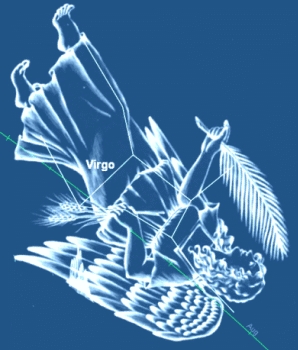
The New World Virgin Goddess Columbia was just a new manifestation of the ancient consort and virgin mother of god.
Depicted in Christianity as the Virgin Mary, Columbia was created out of Virginia and Maryland. To the Masons, the Square is the female aspect.
Washington's original plan for D.C. was a large square with the future Washington Monument (male symbol, compass) at the center.
In Egypt the trinity consists of Isis, Osiris, and Horus the son. Isis can be seen as the ultimate female deity.
Isis may be the oldest deity in Egypt, and certainly the oldest to survive the ages in much the same form. She may also be the most important, for although the other gods were worshipped widely, Isis was worshipped almost universally by all Egyptians. The major goddess of the Egyptian pantheon, she had many of the same attributes of other mother-goddesses found all over the world.
Source
Isis was as powerful, if not more powerful, than Osiris and Ra.
Isis was also known as Sopdet, consort of Sah. Sopdet (Spdt, Sepedet) is Sothis in greek. In 'The Lamentations of Isis and Nephthys for Osiris', Isis calls herself Sopdet. Sopdet was also connected to the goddess Satet at Abu (Elephantine).
Besides these names, the same aspects of any Goddess can be found in:
-
Aphrodite, Ishtar, Black Madonna, Mary/Maya, Goddess Athena, Goddess Astarte, Anunit, Astarte and Atarsamain
-
She was the light-giver at this season of the year and was called Khut
-
As the mighty earth-goddess her name was Usert
-
As the Great Goddess of the Underworld she was Thenenet
-
As the power which shot forth the Nile flood, she was Sati, and Sept
-
As the embracer of the land and producer of fertility by her waters she was Anqet
-
As the producer and giver of life she was Ankhet
-
As the goddess of cultivated lands and fields she was Sekhet
-
As the goddess of the harvest she was Renenet
-
As the goddess of food which was offered to the gods, she was Tcheft, and lived in the Temple of Tchefau
-
As the great lady of the Underworld, who assisted in transforming the bodies of the blessed dead into those wherein they were to live in the realm of Osiris, she was Ament - the "hidden" goddess. As Ament she was declared to be the mother of Ra
-
To the Greeks she was known as Demeter and to the Romans as Ceres
-
To the Chinese protestors of Red Square as the goddess of Democracy
 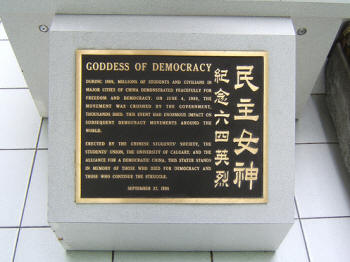
-
And of course the Goddess of the New World - Lady Liberty - Columbia
Attributes of the Goddess
The Goddess can be represented in many different ways.
As Venus she is depicted as, or on a clam shell. She is often depicted as a 5 pointed star, or wearing a pentacle as a crown. There's the Triple Goddess of the 3 phases of the moon. The flag of the District of Columbia has 3 five-pointed stars on it.
As the star Sirius she is the Blazing Star and represents water and the color blue, the Spirit of Wisdom and the Brightly Radiating One or Shinning One.
The sycamore specifically was regarded as a manifestation of the goddesses Nut, Isis and Hathor, who was even given the title, "Lady of the Sycamore." Also as the virgin Columbian Flower with it's 5-Petals.
As Innana, Isis, Athena and Minerva she is often depicted with an Owl.
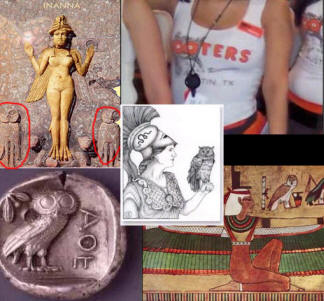
But perhaps the most attributes come when in the form of Columbia.
She is most often shown with an eagle, broken chains and pottery, a cornucopia, images of George Washington, a laurel wreath, a liberty pole and cap, a liberty tree, an olive branch, a rattlesnake, a shield and a stone tablet.
The statue of Columbia that used to stand behind the speaker's chair in the House of Representatives is a fine example. In this one we see the Eagle, and on the other side a snake coiled around a Greek column.
Source

 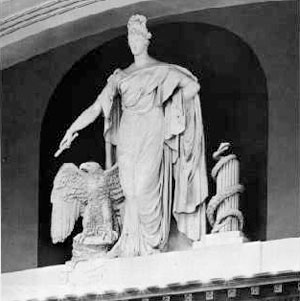
Mother Earth, Primeval Waters, Constellations and Aliens?
Gen.1
[1] In the beginning God created the heaven and the earth.
[2] And the earth was without form, and void; and darkness was upon the face of the deep. And the spirit of God moved upon the face of the waters.
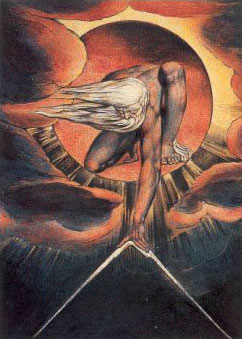
Early in Egyptian history, Isis had absorbed the attributes of all the great primitive goddesses, and of all the local goddesses such as
-
Nekhebet
-
Uatchet
-
Net
-
Bast, Hathor, etc.,
...and she was even identified as the female counterpart of the primeval abyss of water from which sprang all life.
Virgin Mary
The name Mary could have some significance to it's connection with the sea, the Abyss, or the water of life which brings fertility to the land in the form of rain or annual floods.
Usual English form of Maria, which was the Latin form of the New Testament Greek names Μαριαμ (Mariam) or Μαρια (Maria) (the spellings are interchangeable), which were from the Hebrew name מִרְיָם (Miryam). The meaning is not known for certain, but there are several theories including "sea of bitterness."
marine (adj.) Look up marine at Dictionary.com
c.1420, from M.Fr. marin (fem. marine), from O.Fr. marin, from L. marinus (fem. marina) "of the sea," from mare (gen. maris) "sea," from PIE *mori-/*mari- "body of water, lake." Cognate with O.E. mere "sea, lake, pool, pond,"
|
|
|
|
Réponse |
Message 9 de 39 de ce thème |
|
Isis = Sirius, Osiris = Orion
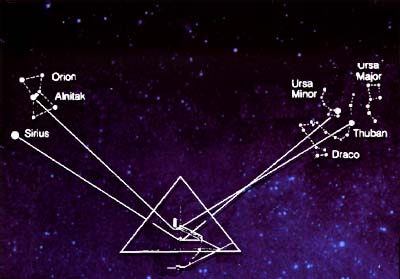
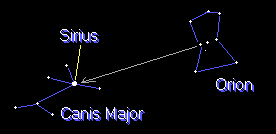
(The goddess star Sirius) In the ancient Vedas this star was known as the Chieftain's star; in other Hindu writings, it is referred to as Sukra, the Rain God, or Rain Star. The Dog is also described as "he who awakens the gods of the air, and summons them to their office of bringing the rain."
Source
This star was the most important of the stars to the ancient Egyptians, and the heliacal rising of this star came at the time of inundation and the start of the Egyptian New Year.
She marked the Summer solstice
As a goddess of the inundation, Sothis was a goddess of fertility.
She also was linked to the pharaoh and his journey in the afterlife. It is interesting to note that Sirius is associated with the flood season. Located just below the Dog Star there exists a constellation called Argo, the Ship.
Near the Cannis Major constellation is the Columb or Dove constellation, depicted with a twig in it's mouth.
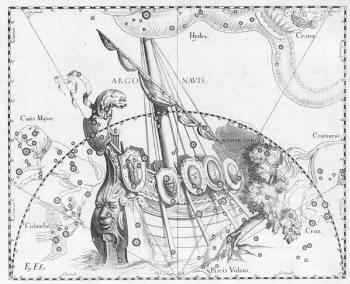
Canis Major and Columba can be seen on the left
The Dogon and Sirius
The Dogon are an ethnic group located mainly in the administrative districts of Bandiagara and Douentza in Mali, West Africa. Dogon religion is defined primarily through the worship of the ancestors and the spirits... They were called the 'Nommo.'
The Dogon are famous for their astronomical knowledge taught through oral tradition... referencing the star system, Sirius.
As the story goes... in the late 1930s, four Dogon priests shared their most important secret tradition with two French anthropologists, Marcel Griaule and Germain Dieterlen after they had spent an apprenticeship of fifteen years living with the tribe. These were secret myths about the star Sirius, which is 8.6 light years from the Earth.
The Dogon priests said that Sirius had a companion star that was invisible to the human eye.
They also stated that the star moved in a 50-year elliptical orbit around Sirius, that it was small and incredibly heavy, and that it rotated on its axis. The Dogons calendar is quite non-traditional in that its fifty year cycle is based neither on the Earth's rotation around the Sun (as is our Julian calendar) nor the cycles of the Moon (a lunar calendar).
Instead, the Dogon culture centers around the rotation cycle Sirius B which encircles the primary star Sirius A every 49.9 - or 50 years...
Since 1844, astronomers had suspected that Sirius A had a companion star. This was in part determined when it was observed that the path of the star wobbled. In 1862 Alvan Clark discovered the second star making Sirius a binary star system (two stars).
The Dogon also claimed that a third star Emme Ya - sorghum female - exists in the Sirius system.
It is described by the Dogan as,
"the seat of the female souls of living or future beings."
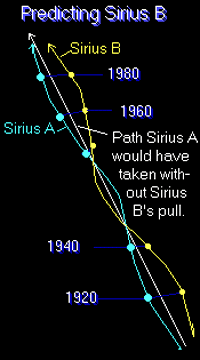
The Nommo
Author Robert Temple describes the Nommo as amphibious beings sent to Earth from the Sirius star system for the benefit of humankind.
They look like Merfolk; Mermaids and Mermen. They called the Nommo 'Masters of the Water', 'The Monitors', 'The Teachers or Instructors', 'Saviors', and 'Spiritual Guardians'.
The Dogon elder, Ogotemelli, describes Nommo as having the upper part as a man and the lower portion as snake; or as having a ram's head with serpent body.
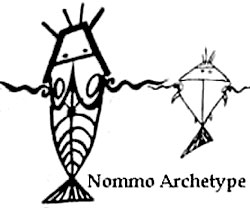
As The Dog Star
As the major star of the "Big Dog" constellation, Sirius is often called the "Dog Star."
The name "Sirius" comes from the Latin Si-rius, from Greek Seirios, "glowing" or "scorcher." The Arabic word Al Shi'ra resembles the Greek, Roman, and Egyptian names suggesting a common origin in Sanskrit, in which the name Surya, the Sun God, simply means the "shining one."
It was thought that Sirius actually added to earth's heat because it was so bright.
This has been used to describe the origin of the phrase "dog days of summer."
Sirius was an object of wonder and veneration to all ancient peoples throughout human history.
The association of Sirius with a celestial dog has been consistent throughout the classical world; even in remote China, the star was identified as a heavenly wolf. In ancient Chaldea (present day Iraq) the star was known as the "Dog Star that Leads," or it was called the "Star of the Dog."
In Assyria, it was said to be the "Dog of the Sun." In still older Akkadia, it was named the "Dog Star of the Sun."
In Greek times Aratus referred to Canis Major as the guard-dog of Orion, following on the heels of its master, and standing on its hind legs with Sirius carried in its jaws. Manilius called it the "dog with the blazing face."
Source
She was occasionally depicted as a large dog, or in Roman times, as the goddess Isis-Sopdet, she was shown riding side-saddle on a large dog. Sometimes she was depicted as a seated cow.
She was also given a masculine aspect, and linked with Horus as Sopdet-Horus during the Middle Kingdom. She was also linked with Anubis during Greek Times as Sopdet-Anubis. (Anubis has the head of a dog or jackal.)
Sirius and Orion Over Washington
The Congress of Isis and Osiris just so happens to happen above... Congress.
Washington D.C. and many of it's buildings and monuments are laid out according to the cardinal directions with the streets running due NS and EW.
In the map of Washington D.C. below, due east is up and the star chart shows the constellation of Orion rising due east over Washington D.C., as it has done every day for the past two hundred years.
Orion's belt points towards Sirius, the brightest star in the sky, and while Orion is rising and low on the eastern horizon, Orion's belt is vertical, pointing to Sirius below.

|
|
|
 Premier
Premier
 Précédent
2 a 9 de 39
Suivant
Précédent
2 a 9 de 39
Suivant Dernier
Dernier
|

